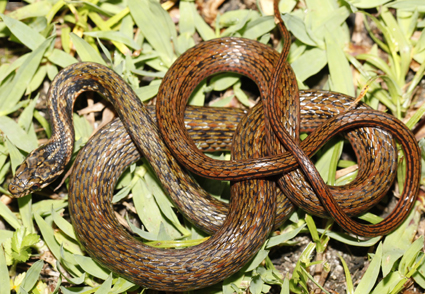Abstract
The original description of Burbrink’s Keelback, Herpetoreas burbrinki was based on a sole damaged specimen collected from Zayu County, Xizang Autonomous Region, China in September 2007. On 16 August 2019, we collected a second live adult female specimen from the type locality. The identity of the species is established based on morphological and molecular comparison with the holotype. One mitochondrial gene (Cytb) and three nuclear genes (C-mos, Rag1, NT3) of the new specimen were sequenced. The four sequences all share the same haplotypes with the holotype. We describe the coloration in life, variation with the type and expand the morphological description of this species.
References
Allen, L. & Vogel, G. (2019) Venomous Snakes of Australia and Oceania / Giftschlangen Australiens und Ozeaniens. Edition Chimaira, Frankfurt am Main, 186 pp.
Blyth, E. (1854) Notices and descriptions of various reptiles, new or little known (part 2). Journal of the Asiatic Society Bengal, Calcutta, 23 (3), 287–302.
Boulenger, G.A. (1899) On a collection of reptiles and batrachians made by Mr. J. D. La Touche in N.W. Fokien, China. Proceedings of the Zoological Society of London, 1899, 159–172.
Burbrink, F.T., Lawson, R. & Slowinski, J.B. (2000) Mitochondrial DNA phylogeography of the polytypic North American ratsnake (Elaphe obsoleta): a critique of the subspecies concept. Evolution, 54, 2107–2118. https://doi.org/10.1111/j.0014-3820.2000.tb01253.x
Burland, T.G. (2000) DNASTAR’s Lasergene sequence analysis software. Methods Molecular Biology, 132, 71–91. https://doi.org/10.1385/1-59259-192-2:71
Che, J., Jiang, K., Yan, F. & Zhang, Y.P. (2020) Amphibians and reptiles in Tibet—diversity and evolution. Chinese Academy of Sciences, Science Press, Beijing, 792 pp. [in Chinese with English abstracts and species descriptions]
Das, A., Gower, D.J. & Deepak, V. (2020) Lost and found: rediscovery and systematics of the Northeast Indian snake Hebius pealii (Sclater, 1891). Vertebrate Zoology, 70 (3), 305–318. https://doi.org/10.26049/VZ70-3-2020-04
Dowling, H.G. (1951) A proposed system for counting ventrals in snakes. British Journal of Herpetology, 1, 97–99.
Dumeìril, A.M.C., Bibron, G. & Dumeìril, A.H.A. (1854) Erpeìtologie geìneìrale ou Histoire Naturelle CompleÌte des Reptiles. Librarie Encyclopediique de Roret, 7 (1), 1–780. [Paris] https://doi.org/10.5962/bhl.title.118797
Gautam, B., Mukesh, K.C., Kul, B.T. & Santosh, B. (2020) Distributional patterns of amphibians and reptiles in Ghandruk, Annapurna Conservation Area, Nepal. IRCF Reptiles & Amphibians, 27 (1), 18–28.
Groth, J.G. & Barrowclough, G.F. (1999) Basal divergences in birds and the phylogenetic utility of the nuclear RAG-1 gene. Molecular Phylogenetics and Evolution, 12, 115–123. https://doi.org/10.1006/mpev.1998.0603
Gumprecht, A., Tillack, F., Orlov, N.L., Captain, A. & Ryabow, S. (2004) Asian pitvipers. Geitje Books, Berlin, 368 pp.
Günther, A. (1860) Contributions to a knowledge of the reptiles of the Himalaya mountains.—I. Descriptions of the new species. II. List of Himalayan reptiles, with remarks on their horizontal distribution. Proceedings of the Zoological Society, London, 1860, 148–175.
Guo, P., Huang, S., Hu, J.R. & Liu, S.Y. (2008) Two snakes new to Xizang Autonomous Region. Sichuan Journal of Zoology, 27, 658–659. [in Chinese]
Guo, P., Liu, S.Y., Huang, S., He, M., Sun, Z.Y., Feng, J.C. & Zhao, E.M. (2009) Morphological variation in Thermophis Malnate (Serpentes: Colubridae), with an expanded description of the type species T. zhaoermii. Zootaxa, 1973 (1), 51–60. https://doi.org/10.11646/zootaxa.1973.1.4
Guo, P., Zhu, F., Liu, Q., Zhang, L., Li, J.X., Huang, Y.Y. & Pyron, R.A. (2014) A taxonomic revision of the Asian keelback snakes, genus Amphiesma (Serpentes: Colubridae: Natricinae), with description of a new species. Zootaxa, 3873 (4), 425–440. https://doi.org/10.11646/zootaxa.3873.4.5
Hu, S.Q. (1987) Amphibians and reptiles in Tibet. Science Press, Beijing, 153 pp. [in Chinese]
Kumar, S., Stecher, G., Li, M., Knyaz, C. & Tamura, K. (2018) MEGA X: Molecular Evolutionary Genetics Analysis across computing platforms. Molecular Biology and Evolution, 35, 1547–1549. https://doi.org/10.1093/molbev/msy096
Lalronunga, S., Lalrinchhana, C., Vanramlina, V., Das A., Gower, D.J. & Deepak, V. (2020) A multilocus molecular perspective on the systematics of the poorly known Northeast Indian colubrid snakes Blythia reticulata (Blyth, 1854), B. hmuifang Vogel, Lalremsanga & Vanlalhrima, 2017, and Hebius xenura (Wall, 1907). Zootaxa, 4768 (2), 193–200. https://doi.org/10.11646/zootaxa.4768.2.2
Lawson, R., Slowinski, J.B., Crother, B.I. & Burbrink, F.T. (2005) Phylogeny of the Colubroidea (Serpentes): New evidence from mitochondrial and nuclear genes. Molecular Phylogenetics and Evolution, 37, 581–601. https://doi.org/10.1016/j.ympev.2005.07.016
Myers, N., Mittermeier, A.R., Mittermeier, C.G., da Fonseca, G.A.B. & Jennifer, K.J. (2000) Biodiversity hotspots for conservation priorities. Nature, 403, 853–858. https://doi.org/10.1038/35002501
Noonan, B.P. & Chippindale, P.T. (2006) Dispersal and vicariance: The complex evolutionary history of boid snakes. Molecular Phylogenetics and Evolution, 40 (2), 347–358. https://doi.org/10.1016/j.ympev.2006.03.010
Sclater, W.L. (1891) Notes on a collection of snakes in the Indian Museum, with descriptions of several new species. Journal of the Asiatic Society of Bengal, LX, 230–250. https://doi.org/10.5962/bhl.title.8746
Shi, L., Lin, X.L. & Zhao, H. (2011) New record of Hemiphyllodactylus yunnanensis to Xizang Autonomous Region, China. Chinese Journal of Zoology, 46 (1), 131–133. [in Chinese]
Stephens, M., Smith, N.J. & Donnelly, P. (2001) A new statistical method for haplotype reconstruction from population data. American Journal of Human Genetics, 68, 978–989. https://doi.org/10.1086/319501
Sun, G.Z., Luo, W.X., Sun, H.Y. & Zhang, G.Y. (2013) A new species of Cascade Frog from Tibet: China. Forestry Construction, 20, 14–16. [in Chinese with English abstract]
Thompson, J.C. (1913) Contribution to the anatomy of the Ophidia. Proceedings of the Zoological Society of London, 83, 414–425. https://doi.org/10.1111/j.1469-7998.1913.tb06139.x
Wall, F. (1907) Some new Asian snakes. Journal of the Bombay Natural History Society, 17, 612–618.
Zhang, L.X., Sheng, Y.S., Yuan, X.Y., An, D., Liu, Z.H., Liao, J.H. & Chen, W. (2019) Duttaphrynus melanostictus found in Xiachayu, Linzhi, Tibet. Chinese Journal of Zoology, 54 (6), 901. [in Chinese]
Zhang, R.Z. (1999) Zoogeography of China. Science Press, Beijing, 330 pp. [in Chinese]
Zhang, R.Z., Zheng, D. & Yang, Q.Y. (1982) Physical geography of Tibet. Science Press, Beijing, 178 pp. [in Chinese]
Zhao, E.M. (2006) Snakes of China. Anhui Sciences and Technology Press, Hefei, 522 pp. [in Chinese]


